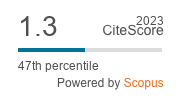The Catching up Processes of the Regions of the Visegrad Group Countries
DOI:
https://doi.org/10.2478/cer-2018-0024Keywords:
economic catching up, Visegrad Group countries, NUTS3 regions, Theil index, breakpoint, agglomeration economiesAbstract
The majority of Central and Eastern European post‑socialist countries acceded to the European Union in 2004. The integration of these economies to the Union had begun earlier, which was strengthened by grants from the Structural Funds after the accession. One of their aims is to facilitate the catching up processes of less developed regions and their convergence to the average of older member states. In our study1, we examine the success of the catching up processes of the NUTS3 regions in the four Visegrad Group countries (V4), i.e., the Czech Republic, Hungary, Poland and Slovakia, between 2000 and 2014 to the average of the 15 initial member states of the European Union. Is there a process of catching up in each region, and if so, is it at a similar or a highly different rate? We analyze the development of GDP per capita at Purchasing Power Parity, and we examine disparities in the level of catching up using entropy‑based Theil indexes. We provide a detailed analysis of two of the influencing factors of the catching up process of regions. Firstly, we look at whether the catching up process of the regions took place in a similar or very different way compared to the national average. Secondly, we examine how the size of the biggest city of the regions affected catching up, and whether the role of the biggest city of region can be shown.
Downloads
References
Artelaris, D., Kallioris, D., Petrakos, D. (2010), Regional Inequalities and Convergence Clubs in the European Union New Member States, ‘Eastern Journal of European Studies’, Vol. 1(1).
Google Scholar
Camagni, R., Capello, R. (2015), Second‑Rank City Dynamics: Theoretical Interpretations Behind Their Growth Potentials, ‘European Planning Studies’, 23(6).
Google Scholar
Capello, R., Caragliu, A., Fratesi, U. (2015), Spatial heterogeneity in the costs of the economic crisis in Europe: are cities sources of regional resilience?, ‘Journal of Economic Geography’, Vol. 15(5).
Google Scholar
Christopher, D. (2007), Introduction to Econometrics, Oxford University Press, Oxford.
Google Scholar
Dijsktra, L., Garcilazo, E., McCann, P. (2013), The Economic Performance of European Cities and City Regions: Myths and Realities, ‘European Planning Studies’, 21(3).
Google Scholar
Donaghy, K.P. (2009), Regional growth and trade in the new economic geography and other recent theories, [in:] Capello, R., Nijkamp, P. (eds.), Handbook of Regional Growth and Development Theories, Edward Elgar, Cheltenham.
Google Scholar
Dorożyński, T., Kuna‑Marszałek, A. (2016), Investment Attractiveness. The Case of the Visegrad Group Countries, ’Comparative Economic Research. Central and Eastern Europe’, Vol. 19(1).
Google Scholar
EC (2013), European System of Accounts, Eurostat, Luxembourg.
Google Scholar
Farkas, B. (2016), Models of Capitalism in the European Union: Post‑crisis Perspectives, Palgrave Macmillan, London.
Google Scholar
Galbraith, J.K., Hale J.T. (2014), The Evolution of Economic Inequality in the United States, 1969–2012: Evidence from Data on Inter‑industrial Earnings and Inter‑regional Incomes, ‘World Economic Review’, 3.
Google Scholar
Goecke, H., Hüther, M. (2016), Regional Convergence in Europe, ‘Intereconomics’, Vol. 51(3).
Google Scholar
Gorzelak, G., Bachtler, J., Smetkowski, M. (eds.) (2010), Regional Development in Central and Eastern European Countries, Routledge, Oxon.
Google Scholar
Lengyel, I. (2016), Competitiveness of Metropolitan Regions in Visegrad Countries, ‘Procedia – Social and Behavioral Sciences’, Vol. 223.
Google Scholar
Lengyel, I. (2017), Competitive and Uncompetitive Regions in Transition Economies: The case of the Visegrad post‑socialist countries, [in:] Huggins, R., Thompson, P. (eds.), Handbook of Regions and Competitiveness. Contemporary Theories and Perspectives on Economic Development, Edward Elgar, Cheltenham.
Google Scholar
Lengyel, I., Vas, Zs., Szakálné, Kanó I., Lengyel, B. (2017), Spatial differences of reindustrialization in a post‑socialist economy: manufacturing in the Hungarian counties, ’European Planning Studies’, Vol. 25(8).
Google Scholar
Lux, G., Horvath, G. (eds.) (2017), The Routledge Handbook to Regional Development in Central and Eastern Europe, Routledge, Abingdon.
Google Scholar
McCann, P., Van Oort, F. (2009), Theories of agglomeration and regional economic growth: a historical review, [in:] Capello, R., Nijkamp, P. (eds.), Handbook of Regional Growth and Development Theories, Edward Elgar, Cheltenham.
Google Scholar
Molendowski, E. (2017), An Internationally Competitive Economy: a Comparison of Poland and the Visegrad Group Countries in the PostAccession Period, ’Comparative Economic Research. Central and Eastern Europe’, Vol. 20(4).
Google Scholar
Neumann, U., Budde, R., Ehlert, C. (2014), Economic Growth in European City Regions, ‘Eastern European Economics’, Vol. 52(1).
Google Scholar
Norkus, Z. (2015), Catching Up And Falling Behind: Four Puzzles after Two Decades of Post‑Communist Transformation, ’Comparative Economic Research. Central and Eastern Europe’, Vol. 18(4).
Google Scholar
Parkinson, M., Meegan, R., Kartecha, J. (2015), City Size and Economic Performance: Is Bigger Better, Small More Beautiful or Middling Marvellous?, ‘European Planning Studies’, 23(6).
Google Scholar
Próchniak, M., Witkowski, B. (2014), On the Stability of the Catching‑Up Process Among Old and New EU Member States, ‘Eastern European Economics’ Vol. 52(2).
Google Scholar
Shorrocks, A.F. (1980), The Class of Additively Decomposable Inequality Measures, ‘Econometrica’, Vol. 48(3).
Google Scholar
Smetkowski, M., Wojcik, P. (2012), Regional Convergence in Central and Eastern European Countries? A Multidimensional Approach, ‘European Planning Studies’, 20(6).
Google Scholar
Storper, M. (2017), Explaining regional growth and change, [in:] Huggins, R., Thompson, P. (eds.), Handbook of Regions and Competitiveness. Contemporary Theories and Perspectives on Economic Development, Edward Elgar, Cheltenham.
Google Scholar
Thissen, M., Van Oort, F., Diodato, D., Ruijs, A. (2013), Regional Competitiveness and Smart Specialization in Europe: Place‑based Development in International Economic Networks, Edward Elgar, Cheltenham.
Google Scholar
Downloads
Published
How to Cite
Issue
Section
License

This work is licensed under a Creative Commons Attribution-NonCommercial-NoDerivatives 4.0 International License.











